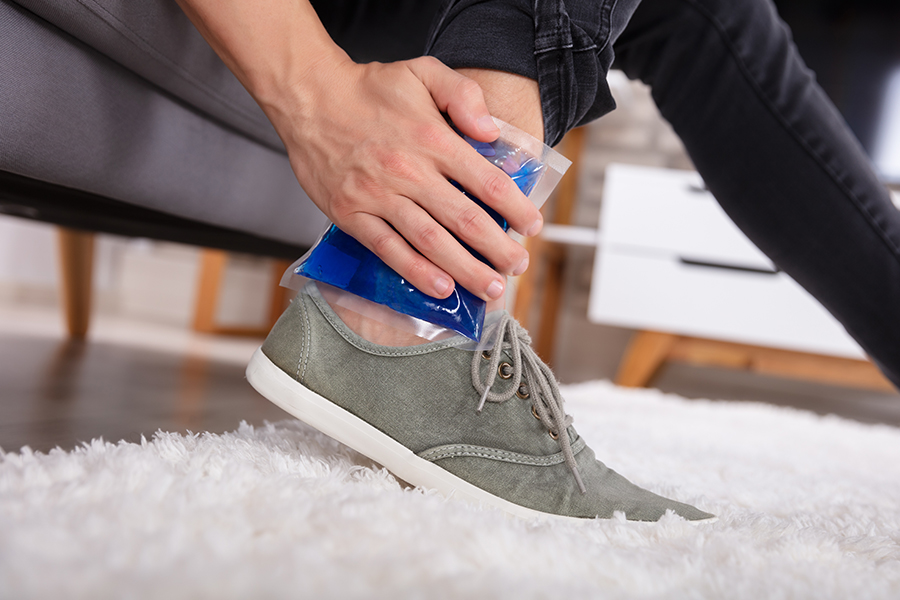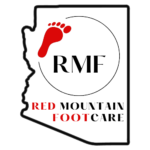6 Common Causes of Ankle Pain

The ankle might seem like a small part of the body, overall, but when something is wrong with this all-important area, it will cause pain, discomfort and can severely limit your mobility. Therefore, any condition negatively impacting your ankle should be addressed in a timely manner by a qualified professional like the podiatrist at Red Mountain Footcare. The following is a breakdown of some common causes associated with ankle pain and discomfort. Learning about them will help you better identify what might be going on in your specific situation.
1.) Sprained Ankle
This is an extremely common problem that almost everyone has experienced at one time of their life or another. A sprained ankle occurs when the ligaments or tissue that hold your ankle bones together tears. This type of injury can happen easily, even just rolling your foot sideways can result in a sprain. The pain associated with a sprained ankle can be severe, limiting your mobility, or can be considered mild.
Symptoms of a Sprained Ankle:
- Bruising.
- Swelling.
- Instability in ankle joint.
- Tenderness to the touch.
- Limited range of motion in the ankle.
- A sound or popping when you injured the joint.
- Pain, which intensifies when you try to put weight on the injured foot.
Treatment Options For Sprained Ankle:
- Rest, stay off your ankle.
- Ice for 20-minute intervals.
- Compress the ankle joint with elastic bandages.
- Elevate your ankle above your heart.
- In most cases, a mild sprain will improve on its own within a few days with rest and home care. If it doesn’t, a doctor might put you in a walking boot or short cast and then recommend physical therapy.
2.) Osteoarthritis
This is the single most common form of arthritis and currently impacts millions of people’s lives worldwide. Osteoarthritis damage joints in your body. Though it can affect any joint, it most often impacts your spine, hips, knee, spine and sometimes your ankles. This degenerative condition causes the cartilage that provides the ends of your bones cushion to wear away. The end result is two bones rubbing together, with no cushion in between, which of course is extremely painful.
Symptoms of Osteoarthritis:
- A loss of flexibility or stiffness in the joint. It is usually the most noticeable after you have been sedentary for a long period of time.
- Tenderness within the joint when pressure is applied.
- Pain and discomfort within the joint after moving.
- Feeling a grating sensation when you move the joint.
Treatment Options for Osteoarthritis:
- Steroid shots or anti-inflammatory drugs to cut down on the swelling.
- Physical therapy to strengthen surrounding areas.
- Brace to keep your ankle from moving as much.
- Surgery.
3.) Gout
Gout is another form of arthritis that often causes tenderness and redness, swelling, and severe pain at the base of your big toe. Although it is commonly associated with the big toe, gout can cause pain in your ankle area as well. This occurs when the uric acid, which is a waste product produced by gout, forms needle-sharp crystals that develop in your joints. As you might expect, this can result in intense, severe pain and swelling.
Symptoms of Gout:
- Limited range of motion, making moving your joints difficult.
- Redness and inflammation in the affected joints. Joints can also become tender, swollen, red and warm.
- Discomfort that just won’t go away. Some discomfort seems to just stick around in between periods of severe pain.
- Intense pain in your joints.
Treatment Options For Gout:
- Rest.
- Medications to counteract the attack.
- Changing your diet to a “gout diet.”
- Keeping a good exercise regimen.
4.) Flat Feet
This condition is exactly as it sounds, your arch is flattened, causing your foot to be flat. Sometimes, this is a result of genetics, other times it’s due to an injury. Though it is usually a painless condition, your ankles can swell and hurt as a result of your foot not supporting your body weight properly.
Treatments For Flat Feet:
- Physical therapy.
- Supportive shoes or wearing arch supports.
- Visit a podiatrist.
5.) Ankle Fracture
On occasion, your ankle is hurting because one of the bones that form your ankle, your talus, fibula and tibia is cracked or broken. Usually, you will know you hurt yourself as the pain will come on almost immediately after the event occurred.
Symptoms of a Broken Ankle or Foot
- Pain that decreases with rest but increases when active.
- Throbbing, immediate pain.
- Bruising.
- Swelling.
- Tenderness.
- Difficulty bearing weight or walking.
- Deformity.
Treatment Options For a Broken Ankle
- Go see a doctor as soon as possible, who will likely suggest a cast or splint in order to keep your ankle/foot bones in place, or even recommend surgery. In the meantime, remember R.I.C.E.:
- Rest your foot.
- Ice your foot.
- Compress your foot with wrapping.
- Elevate your foot until you can be seen by a doctor.
6.) Achilles Tendinitis
This condition is most often a result of overuse. It occurs when the band of tissue (tendons) that connects your heel bone and your lower leg tear. The tears are tiny, but the damage causes your ankle to feel warm above your heel and swell.
Symptoms of Achilles Tendinitis:
- Often begins with just a mild ache above the heel or in the back of the leg.
- More severe pain might occur after sprinting, stair climbing or running.
- Stiffness and tenderness in the area, especially in the morning.
Treatment for Achilles Tendinitis:
- Heel lifts and stretching.
- Rest, this is key to your healing.
- Anti-inflammatory drugs.
- Physical therapy.
- Surgery, only in severe cases where scar tissue has formed and is causing ongoing pain and discomfort.
The above are six common reasons your ankle might be giving you trouble. Of course, there are more possibilities and only a professional, such as the podiatrist at Red Mountain Footcare can properly determine what is going on in your case. Contact them today to book an appointment and begin treating your ankle pain.
